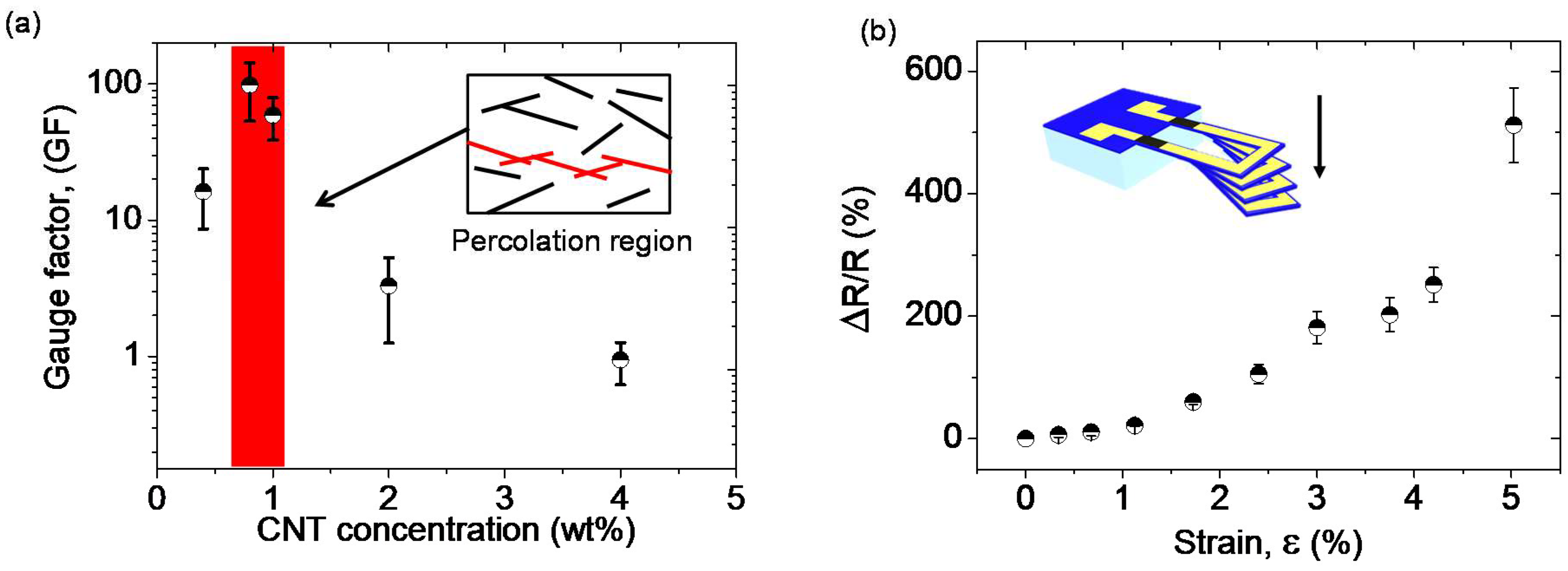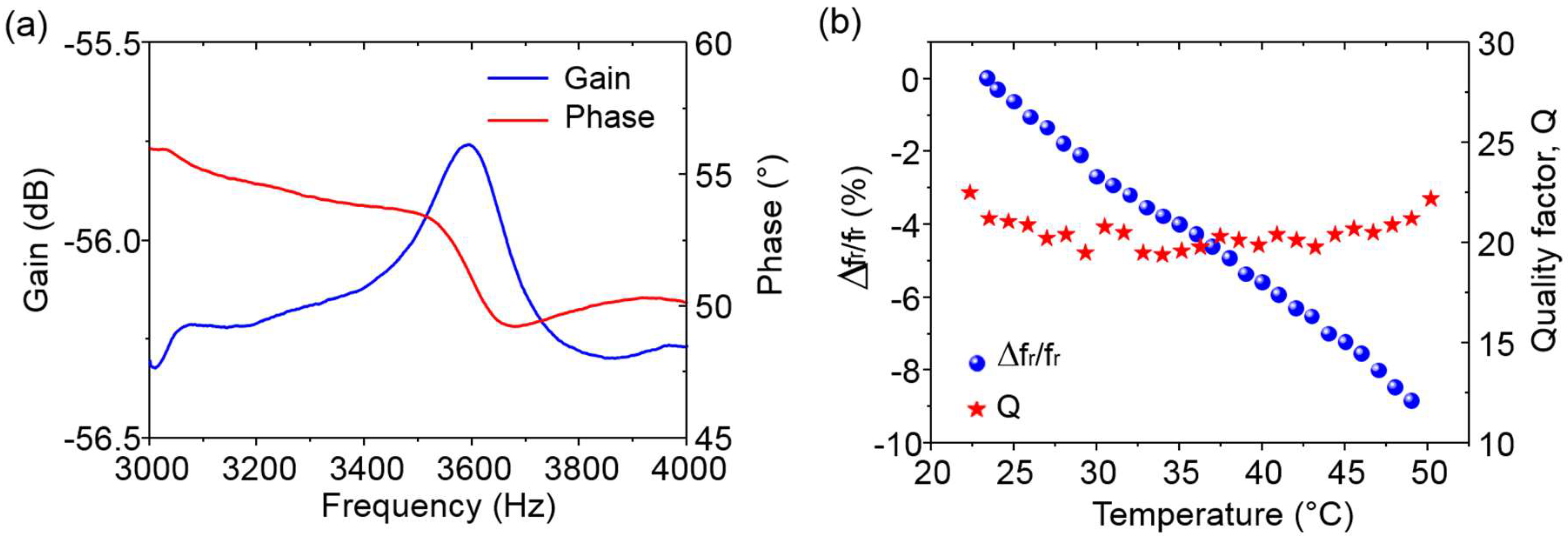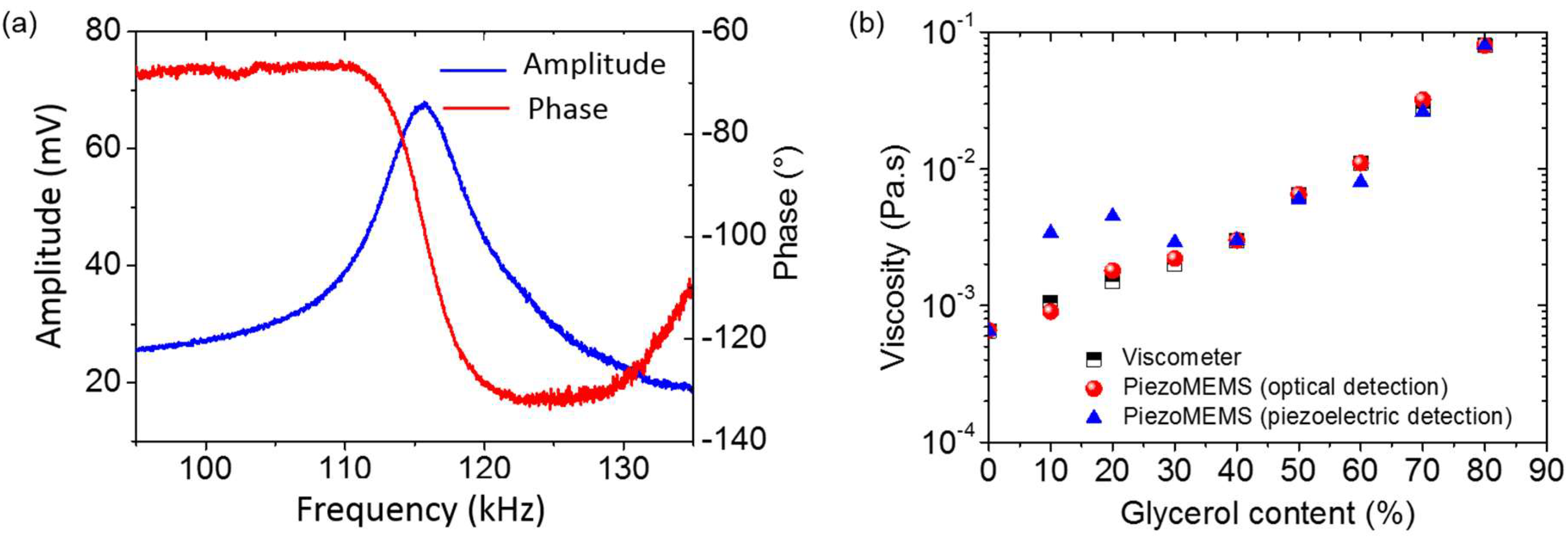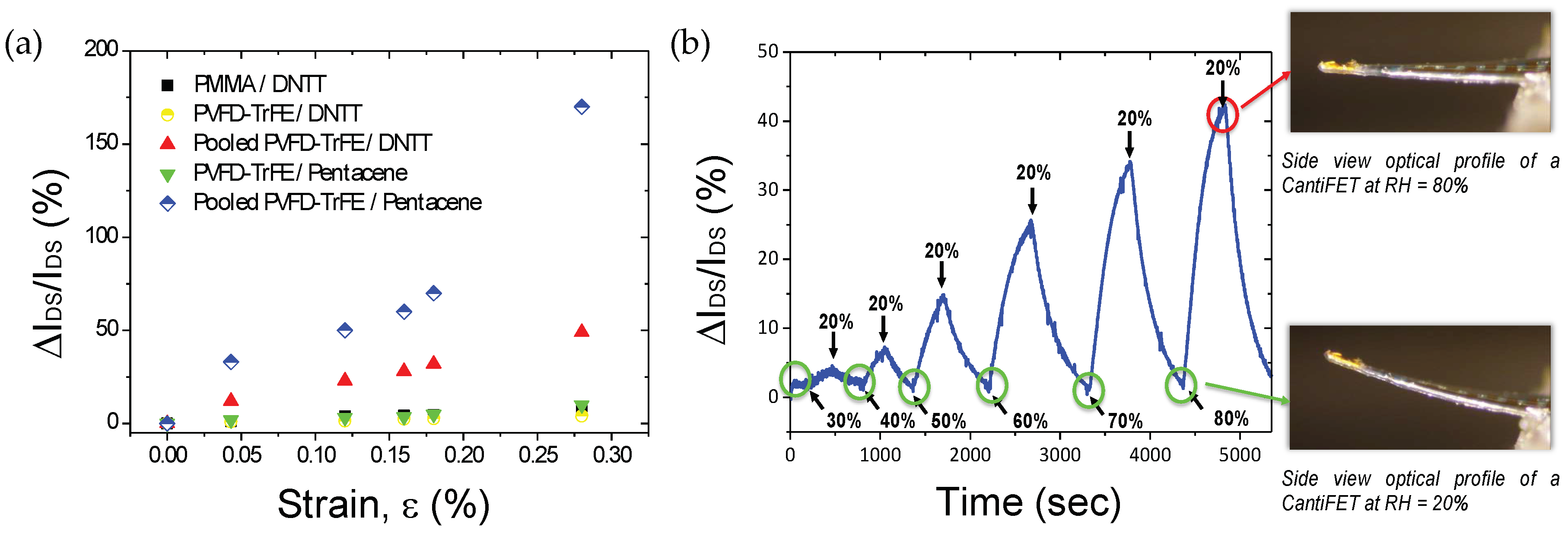Integrated Electromechanical Transduction Schemes for Polymer MEMS Sensors
Abstract
1. Introduction
2. Materials and Methods
3. Results and Discussion
3.1. Piezoresistive Transduction
3.1.1. Static Mode
3.1.2. Dynamic Mode
3.2. Piezoelectric Polymer Transducer
3.3. Piezotransistive Transducer from P(VDF-TrFE)-Gated OFET
4. Conclusions
Acknowledgments
Author Contributions
Conflicts of Interest
References
- Liu, C. Recent Developments in Polymer MEMS. Adv. Mater. 2007, 19, 3783–3790. [Google Scholar] [CrossRef]
- Kim, B.J.; Meng, E. Review of polymer MEMS micromachining. J. Micromech. Microeng. 2015, 26, 013001. [Google Scholar] [CrossRef]
- Villanueva, L.G.; Bausells, J.; Brugger, J. Grand Challenge in N/MEMS. Front. Mech. Eng. 2016, 1, 15. [Google Scholar] [CrossRef]
- Srinivasan, A.; Bandyopadhyay, S. Advances in Polymer Materials and Technology, 1st ed.; Taylor Francis CRC Press: Boca Raton, FL, USA, 2016; 824p. [Google Scholar]
- Nordström, M.; Keller, S.; Lillemose, M.; Johansson, A.; Dohn, S.; Haefliger, D.; Blagoi, G.; Havsteen-Jakobsen, M.; Boisen, A. SU-8 cantilevers for bio/chemical sensing: Fabrication, characterization and development of novel read-out methods. Sensors 2008, 8, 1595–1612. [Google Scholar] [CrossRef] [PubMed]
- Abgrall, P.; Conedera, V.; Camon, H.; Gue, A.-M.; Nguyen, N.-T. SU-8 as a structural material for labs-on-chip and microelectromechanical systems. Electrophoresis 2007, 28, 4539–4551. [Google Scholar] [CrossRef] [PubMed]
- Ferrell, N.; Woodard, J.; Hansford, D. Fabrication of polymer microstructures for MEMS: Sacrificial layer micromolding and patterned substrate micromolding. Biomed. Microdevices 2007, 9, 815–821. [Google Scholar] [CrossRef] [PubMed]
- Van Oosten, C.L.; Bastiaansen, C.W.; Broer, D.J. Printed artificial cilia from liquid-crystal network actuators modularly driven by light. Nat. Mater. 2009, 8, 677–682. [Google Scholar] [CrossRef]
- Greve, A.; Keller, S.; Vig, A.L.; Kristensen, A.; Larsson, D.; Yvind, K.; Hvam, J.M.; Cerruti, M.; Majumdar, A.; Boisen, A. Thermoplastic microcantilevers fabricated by nanoimprint lithography. J. Micromech. Microeng. 2010, 20, 015009. [Google Scholar] [CrossRef]
- Ayela, C.; Dubourg, G.; Pellet, C.; Haupt, K. All-organic Microelectromechanical Systems Integrating Specific Molecular Recognition—A New Generation of Chemical Sensors. Adv. Mater. 2014, 26, 5876. [Google Scholar] [CrossRef] [PubMed]
- Haefliger, D.; Boisen, A. Three-dimensional microfabrication in negative resist using printed masks. J. Micromech. Microeng. 2006, 16, 951. [Google Scholar] [CrossRef]
- Foulds, I.G.; Parameswaran, M. A planar self-sacrificial multilayer SU-8-based MEMS process utilizing a UV-blocking layer for the creation of freely moving parts. J. Micromech. Microeng. 2006, 16, 2109. [Google Scholar] [CrossRef]
- Dubourg, G.; Fadel-Taris, L.; Dufour, I.; Pellet, C.; Ayela, C. Collective microfabrication of all-organic microcantilevers platform based on the hierarchical combination of shadow-masking and wafer bonding processing methods. J. Micromech. Microeng. 2011, 21, 095021. [Google Scholar] [CrossRef]
- Chia Gomez, L.P.; Spangenberg, A.; Ton, X.-A.; Fuchs, Y.; Bokeloh, F.; Malval, J.-P.; Tse Sum Bui, B.; Thuau, D.; Ayela, C.; Haupt, K.; et al. Rapid prototyping of chemical microsensors based on molecularly imprinted polymers synthesized by 2-photon stereolithography. Adv. Mater. 2016, 28, 5931–5937. [Google Scholar] [CrossRef] [PubMed]
- Accoto, C.; Qualtieri, A.; Pisanello, F.; Ricciardi, C.; Pirri, C.F.; De Vittorio, M. Two-photon polymerization lithography and laser doppler vibrometry of a SU-8-based suspended microchannel resonator. J. Microelectromech. Syst. 2015, 24, 1038. [Google Scholar] [CrossRef]
- Brand, O.; Dufour, I.; Heinrich, S.; Josse, F. Resonant MEMS: Fundamentals, Implementation, and Application, 1st ed.; Wiley-VCH: Weinheim, Germany, 2015; 512p. [Google Scholar]
- Lang, U.; Rust, P.; Dual, J. Towards fully polymeric MEMS: Fabrication and testing of PEDOT/PSS strain gauges. Microelectron. Eng. 2008, 85, 1050–1053. [Google Scholar] [CrossRef]
- Gammelgaard, L.; Rasmussen, P.A.; Calleja, M.; Vettiger, P.; Boisen, A. Microfabricated photoplastic cantilever with integrated photoplastic/carbon based piezoresistive strain sensor. Appl. Phys. Lett. 2006, 88, 113508. [Google Scholar] [CrossRef]
- Seena, V.; Rajorya, A.; Pant, P.; Mukherji, S.; Rao, V.R. Polymer microcantilever biochemical sensors with integrated polymer composites for electrical detection. Solid State Sci. 2009, 11, 1606–1611. [Google Scholar] [CrossRef]
- Siong, L.K.; Azid, I.A.; Sidek, O.; Ibrahim, K.; Devarajan, M. SU-8 piezoresistive microcantilever with high gauge factor. IET Micro Nano Lett. 2013, 8, 123–126. [Google Scholar] [CrossRef]
- Loyola, B.R.; La Saponara, V.; Loh, K.J. In situ strain monitoring of fiber-reinforced polymers using embedded piezoresistive nanocomposites. J. Mater. Sci. 2010, 45, 6786–6798. [Google Scholar] [CrossRef]
- Seena, V.; Fernandes, A.; Pant, P.; Mukherji, S.; Ramgopal Rao, V. Polymer nanocomposite nanomechanical cantilever sensors: Material characterization, device development and application in explosive vapour detection. Nanotechnology 2011, 22, 295501. [Google Scholar] [CrossRef] [PubMed]
- Seena, V.; Hari, K.; Prajakta, S.; Rudra Pratap, R.; Ramgopal Rao, V. A novel piezoresistive polymer nanocomposite MEMS accelerometer. J. Micromech. Microeng. 2017, 27, 015014. [Google Scholar] [CrossRef]
- Lee, K.; Lee, S.S.; Lee, J.A.; Lee, K.C.; Ji, S. Carbon nanotube film piezoresistors embedded in polymer membranes. App. Physics Lett. 2010, 96, 013511. [Google Scholar] [CrossRef]
- Wang, Y.; Wang, A.X.; Wang, Y.; Chyu, M.K.; Wang, Q.M. Fabrication and characterization of carbon nanotube–polyimide composite based high temperature flexible thin film piezoresistive strain sensor. Sens. Actuators A Phys. 2013, 199, 265–271. [Google Scholar] [CrossRef]
- Hu, B.; Hu, N.; Li, Y.; Akagi, K.; Yuan, W.; Watanabe, T.; Cai, Y. Multi-scale numerical simulations on piezoresistivity of CNT/polymer nanocomposites. Nanoscale Res. Lett. 2012, 7, 402. [Google Scholar] [CrossRef] [PubMed]
- Park, M.; Kim, H.; Yougblood, J.P. Strain-dependent electrical resistance of multi-walled carbon nanotube/polymer composite films. Nanotechnology 2008, 19, 55705–55715. [Google Scholar] [CrossRef] [PubMed]
- Thuau, D.; Ayela, C.; Poulin, P.; Dufour, I. Highly piezoresistive hybrid MEMS sensors. Sens. Actuators A Phys. 2014, 209, 161–168. [Google Scholar] [CrossRef]
- Thuau, D.; Ayela, C.; Lemaire, E.; Heinrich, S.; Poulin, P.; Dufour, I. Advanced thermo-mechanical characterization of organic materials by piezoresistive organic resonators. Mater. Horiz. 2015, 2, 106–112. [Google Scholar] [CrossRef]
- Tadigadapa, S.; Mateti, K. Piezoelectric MEMS sensors: State-of-the-art and perspectives. Meas. Sci. Technol. 2009, 20, 092001. [Google Scholar] [CrossRef]
- Wang, Z.L.; Song, J. Piezoelectric Nanogenerators Based on Zinc Oxide Nanowire Arrays. Science 2006, 312, 242–246. [Google Scholar] [CrossRef] [PubMed]
- Demartin Maeder, M.; Damjanovic, D.; Setter, N. Lead Free Piezoelectric Materials. J. Electro. 2004, 13, 385–392. [Google Scholar] [CrossRef]
- Jung, J.H.; Lee, M.; Hong, J.; Ding, J.; Chen, C.Y.; Chou, L.J.; Wang, Z.L. Lead-Free NaNbO3 Nanowires for a High Output Piezoelectric Nanogenerator. ACS Nano. 2011, 5, 10041–10046. [Google Scholar] [CrossRef] [PubMed]
- Thuau, D.; Kallitsis, K.; Domingues Dos Santos, F.; Hadziioannou, G. All inkjet-printed piezoelectric electronic devices: Energy generators, sensors and actuators. J. Mater. Chem. C 2017, 5, 9963–9966. [Google Scholar] [CrossRef]
- Pabst, O.; Perelaer, J.; Beckert, E.; Schubert, U.S.; Eberhardt, R.; Tunnermann, A. All inkjet-printed piezoelectric polymer actuators: Characterization and applications for micro-pumps in lab-on-a-chip systems. Org. Electron. 2013, 14, 3423–3429. [Google Scholar] [CrossRef]
- Ramadan, K.S.; Sameoto, D.; Evoy, S. A review of piezoelectric polymers as functional materials for electromechanical transducers. Smart Mater. Struct. 2014, 23, 033001. [Google Scholar] [CrossRef]
- Ducrot, P.H.; Dufour, I.; Ayela, C. Optimization of PVDF-TrFE Processing Conditions for the Fabrication of Organic MEMS Resonators. Sci. Rep. 2016, 6, 19426. [Google Scholar] [CrossRef] [PubMed]
- Sousa, P.M.; Gutiérrez, M.; Mendoza, E.; Llobera, A.; Chu, V.; Conde, J.P. Microelectromechanical resonators based on all polymer/carbon nanotube composite structural material. Appl. Phys. Lett. 2011, 99, 044104. [Google Scholar] [CrossRef]
- Schmid, S.; Wendlandt, M.; Junker, D.; Hierold, C. Nonconductive polymer microresonators actuated by the kelvin polarization force. Appl. Phys. Lett. 2006, 89, 163506. [Google Scholar] [CrossRef]
- Dubourg, G.; Dufour, I.; Pellet, C.; Ayela, C. Optimization of the performances of SU-8 organic microcantilever resonators by tuning the viscoelastic properties of the polymer. Sens. Actuators B Chem. Elsevier 2012, 169, 320–326. [Google Scholar] [CrossRef]
- Shekhawat, G.; Tark, S.H.; Dravid, V.P. MOSFET-Embedded microcantilevers for measuring deflection in biomolecular sensors. Science 2006, 311, 1592. [Google Scholar] [CrossRef] [PubMed]
- Tark, S.H.; Srivastava, A.; Chou, S.; Shekhawat, G.; Dravid, V.P. Microcantilever array with embedded metal oxide semiconductor field effect transistor actuators for deflection control, deflection sensing, and high frequency oscillation. Appl. Phys. Lett. 2009, 94, 104. [Google Scholar] [CrossRef]
- Mostafa, S.; Lee, I.; Islam, S.K.; Eliza, S.A.; Shekhawat, G.; Dravid, V.P.; Tulip, F.S. Integrated MOSFET-Embedded-Cantilever-Based Biosensor Characteristic for Detection of Anthrax Simulant. IEEE Electron Devices Lett. 2011, 32, 408–410. [Google Scholar] [CrossRef]
- Talukdar, A.; Khan, F.M.; Lee, D.; Kim, S.; Thundat, T.; Koley, G. Piezotransistive transduction of femtoscale displacement for photoacoustic spectroscopy. Nat. Commun. 2015, 6, 7885. [Google Scholar] [CrossRef] [PubMed]
- Seena, V.; Nigam, A.; Pant, P.; Mukherji, S.; Rao, V.R. “Organic CantiFET”: A Nanomechanical polymer cantilever sensor with integrated OFET. J. Microelectromech. Syst. 2012, 21, 294. [Google Scholar] [CrossRef]
- Thuau, D.; Abbas, M.; Wantz, G.; Hirsch, L.; Dufour, I.; Ayela, C. Piezoelectric polymer gated OFET: Cutting-edge electro-mechanical transducer for organic MEMS-based sensors. Sci. Rep. 2016, 6, 38672. [Google Scholar] [CrossRef] [PubMed]
- Ray, P.; Rao, V.R. Al-Doped ZnO thin-film transistor embedded micro-cantilever as a piezoresistive sensor. Appl. Phys. Lett. 2013, 102, 064101. [Google Scholar] [CrossRef]
- Lemaire, E.; Thuau, D.; Caillard, B.; Dufour, I. Fast-fabrication process for low environmental impact microsystems. J. Clean. Prod. 2015, 108, 207–216. [Google Scholar] [CrossRef]
- Niedermayer, A.O.; Voglhuber-Brunnmaier, T.; Sell, J.; Jakoby, B. Methods for the robust measurement of the resonant frequency and quality factor of significantly damped resonating devices. Meas. Sci. Technol. 2012, 23, 085107. [Google Scholar] [CrossRef]
- Heinisch, M.; Voglhuber-Brunnmaier, T.; Reichel, E.K.; Dufour, I.; Jakoby, B. Reduced order models for resonant viscosity and mass density sensors. Sens. Actuators A Phys. 2014, 220, 76–84. [Google Scholar] [CrossRef]
- Heinisch, M. Mechanical Resonators for Liquid Viscosity and Mass Density Sensing. Ph.D. Thesis, Johanes Kepler University, Linz, Austria, 2015. [Google Scholar]




| MEMS. | Transduction | Actuation | Micromachining | Operating Mode | Sensitivity Max | Applications |
|---|---|---|---|---|---|---|
| Piezoresistive cantilever [5,17,18,19,20,21,22,23,24,25,26,27,28,29] | Piezoresistive | - | Photo-patternable Bulk stacking | Static and Dynamic | 200 [28] | Strain, temperature, gas sensing |
| Piezoelectric resonator [31,32,33,34,35,36,37] | Piezoelectric | Piezoelectric | Bulk stacking | Dynamic | NA | Liquid sensing, energy harvesting |
| OFET-embedded cantilever [45,46] | Piezotransistive | - | Bulk stacking | Static | 600 [46] | Strain, gas sensing |
© 2018 by the authors. Licensee MDPI, Basel, Switzerland. This article is an open access article distributed under the terms and conditions of the Creative Commons Attribution (CC BY) license (http://creativecommons.org/licenses/by/4.0/).
Share and Cite
Thuau, D.; Ducrot, P.-H.; Poulin, P.; Dufour, I.; Ayela, C. Integrated Electromechanical Transduction Schemes for Polymer MEMS Sensors. Micromachines 2018, 9, 197. https://doi.org/10.3390/mi9050197
Thuau D, Ducrot P-H, Poulin P, Dufour I, Ayela C. Integrated Electromechanical Transduction Schemes for Polymer MEMS Sensors. Micromachines. 2018; 9(5):197. https://doi.org/10.3390/mi9050197
Chicago/Turabian StyleThuau, Damien, Pierre-Henri Ducrot, Philippe Poulin, Isabelle Dufour, and Cédric Ayela. 2018. "Integrated Electromechanical Transduction Schemes for Polymer MEMS Sensors" Micromachines 9, no. 5: 197. https://doi.org/10.3390/mi9050197
APA StyleThuau, D., Ducrot, P.-H., Poulin, P., Dufour, I., & Ayela, C. (2018). Integrated Electromechanical Transduction Schemes for Polymer MEMS Sensors. Micromachines, 9(5), 197. https://doi.org/10.3390/mi9050197






